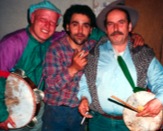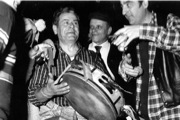Tammurriata-"The Rhythm of Vesuvius"
The first time that I heard the rhythm of the tammurriata I was blown away. It was such an ancient sound with the rhythm of a fast heartbeat. After 12 years of being in the middle of the Tammurriata scene it still sounds exotic to me.
I went to Istanbul in 1994 to study the music. I was amazed at the similarity of the Turkish modes to those of the Tammurriata. To be technical for a minute, (you’ll have to excuse me if my music theory fails me a bit, but I studied it 24 years ago), the Tammurriata plays in a scale that is actually the major scale of the 4th from the fundamental pitch. For example; if the Tammurriata is in the key of “F”, the melody notes are in the key of “C”. If I explained it correctly, it’s just the same with many Turkish and Kurdish melodies. Napoli was invaded several time by the Turks and the proof is still there in the music. I noticed that many dirty words are also very similar in Turkish and Neapolitan dialects.
The Tammurriata dates from pre-christian times as is visible from the famous mosaic taken from the excavations of Pompeii at the top of this page. Originally the tammurriata was performed only as voice and tammora. Tammora is the particular very large tambourine used in the tammurriata. It was later joined by reed flutes similar to the Sardegnian Launedas for melody.
Today the tammurriata is performed on any combination of tammora, accordion, guitar, Jew's harp, putipú, scetavaesé, tricabalache and always castanets used by the dancers or the singers. But the `two indispensable instruments are the tammora and the voice.
-
1.Putipú-A friction drum with a long cane attached to the center of the drum skin played by rubbing the cane with a wet sponge. It makes a very deep vocal grunting sound.
-
2.Tricabalache-Three wooden hammers of equal size hinged at the base and covered with metal tambourine jingles. The two outermost hammers are held in the middle by two hands and banged into the middle hammer. I’ve seen them from very small to more than 2 meters high.
-
3.Scetavaesé-Two sticks, one serrated like a saw, and the other a simple stick. Both are covered with metal tambourine jingles. They are sawed together and make a kind of metallic drum roll sound. They’re often played with one stick under the chin to mimic a violin.
 The dancers are a vital part of the experience. Clicking their castanets in steady rhythm the dancing can be sensual and sexually charged to hypnotic even sometimes violent. Today it is danced by the very young to people so old that it’s a real wonder to see them moving so much.
The dancers are a vital part of the experience. Clicking their castanets in steady rhythm the dancing can be sensual and sexually charged to hypnotic even sometimes violent. Today it is danced by the very young to people so old that it’s a real wonder to see them moving so much.In the city of Naples , the tammurriata al but died out completely. But in the villages under Mt. Vesuvius the tammurriata was handed down from parent to child in the fields for more than two thousand years. In the last 10 years, there has been a big resurgence of the tammurriata in the area. This is a very positive thing in my opinion, but has also it’s bad side as well. Thanks to the invention of recording equipment, most of the youth are learning the music from recordings instead of actually getting it from a life in the fields with their family. The result of this combined with the fact fact that many of the old masters are dying out having never been recorded is that the tammurriata scene is beginning to get a bit watered down by inexperience. When I first started going to the festivals I couldn’t believe how “real” the musicians were. In fact I remember that there were no real professional musicians at all. They were all farmers or working class people making real folk music because it’s what their people has always done.
©2007 StranieroVision

Tammurriata
Friday 16 March 2001

